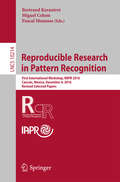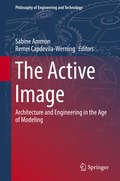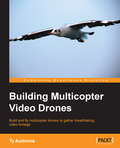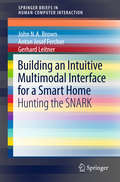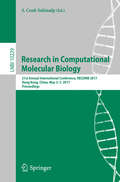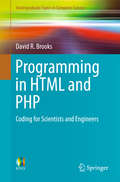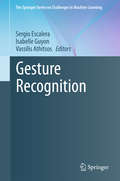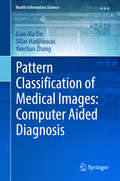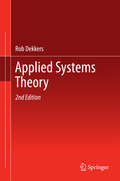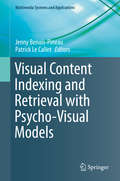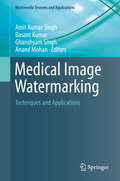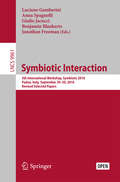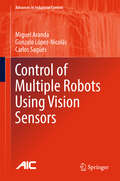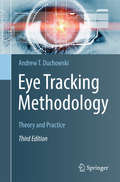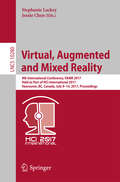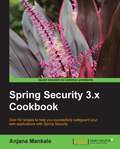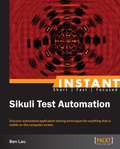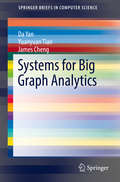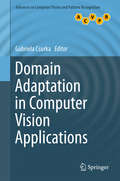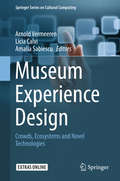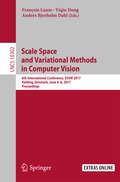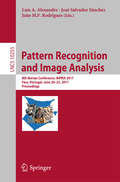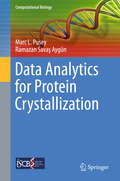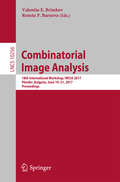- Table View
- List View
Reproducible Research in Pattern Recognition: First International Workshop, RRPR 2016, Cancún, Mexico, December 4, 2016, Revised Selected Papers (Lecture Notes in Computer Science #10214)
by Bertrand Kerautret Miguel Colom Pascal MonasseThis book constitutes the thoroughly refereed post-proceedings of the First International Workshop on Reproducible Research in Pattern Recognition, RRPR 2016, held in Cancún, Mexico, in December 2016. The 12 revised full papers, among them 2 invited talks, presented were carefully reviewed and selected from 16 submissions. They focus on pattern recognition algorithms; reproducible research frameworks; reproducible research results, previous works on reproducible research.
The Active Image: Architecture and Engineering in the Age of Modeling (Philosophy of Engineering and Technology #28)
by Sabine Ammon Remei Capdevila-WerningThe “active image” refers to the operative nature of images, thus capturing the vast array of “actions” that images perform. This volume features essays that present a new approach to image theory. It explores the many ways images become active in architecture and engineering design processes and how, in the age of computer-based modeling, images play an indispensable role.The contributors examine different types of images, be they pictures, sketches, renderings, maps, plans, and photographs; be they analog or digital, planar or three-dimensional, ephemeral, realistic or imaginary. Their essays investigate how images serve as means of representing, as tools for thinking and reasoning, as ways of imagining the inexistent, as means of communicating and conveying information and how images may also perform functions and have an agency in their own.The essays discuss the role of images from the perspective of philosophy, theory and history of architecture, history of science, media theory, cognitive sciences, design studies, and visual studies, offering a multidisciplinary approach to imagery and showing the various methodologies and interpretations in current research. In addition, they offer valuable insight to better understand how images operate and function in the arts and sciences in general.
Building Multicopter Video Drones
by Ty AudronisThis book is for a wide range of individuals who are looking to shoot aerial footage with a multicopter. No previous flying experience is assumed, but even the most expert flyers will find unexpected and interesting information.
Building an Intuitive Multimodal Interface for a Smart Home: Hunting the SNARK (Human–Computer Interaction Series)
by John N.A Brown Anton Josef Fercher Gerhard LeitnerThis book describes an innovative approach to the interaction between humans and a smart environment; an attempt to get a smart home to understand intuitive, multi-modal, human-centred communication. State of the art smart homes, like other “smart” technology, tend to demand that the human user must adapt herself to the needs of the system. The hunt for a truly user-centred, truly intuitive system has long proven to be beyond the grasp of current technology.When humans speak with one another, we are multimodal. Our speech is supplemented with gestures, which serve as a parallel stream of information, reinforcing the meaning of our words.Drawing on well-established protocols in engineering and psychology, and with no small amount of inspiration from a particular nonsense poem, we have successfully concluded that hunt. This book describes the efforts, undertaken over several years, to design, implement, and test a model of interaction that allows untrained individuals to intuitively control a complex series of networked and embedded systems. The theoretical concepts are supported by a series of experimental studies, showing the advantages of the novel approach, and pointing towards future work that would facilitate the deployment of this concept in the real world.
Research in Computational Molecular Biology: 21st Annual International Conference, RECOMB 2017, Hong Kong, China, May 3-7, 2017, Proceedings (Lecture Notes in Computer Science #10229)
by S. Cenk SahinalpThis book constitutes the proceedings of the 21th Annual Conference on Research in Computational Molecular Biology, RECOMB 2017, held in Hong Kong, China, in May 2017. The 22 regular papers presented in this volume were carefully reviewed and selected from 184 submissions. 16 short abstracts are included in the back matter of the volume. They report on original research in all areas of computational molecular biology and bioinformatics
Programming in HTML and PHP: Coding for Scientists and Engineers (Undergraduate Topics in Computer Science)
by David R. BrooksThis concise and accessible textbook will enable readers to quickly develop the working skills necessary to solve computational problems in a server-based environment, using HTML and PHP. The importance of learning by example (as opposed to simply learning by copying) is emphasized through extensive use of hands-on exercises and examples, with a specific focus on useful science and engineering applications. The clearly-written text is designed to be simple to follow for the novice student, without requiring any background in programming or mathematics beyond algebra.Topics and features: describes the creation of HTML pages and the characteristics of HTML documents, showing how to use HTML tables, forms, lists, and frames to organize documents for use with PHP applications; explains how to set up a PHP environment, using a local or remote server; introduces the capabilities and syntax of the PHP language, including coverage of array syntax and use; examines user-defined functions in programming, summarizing PHP functions for reading and writing files, viewing the content of variables, and manipulating strings; reviews the PHP GD graphics library, presenting applications for creating pie charts, bar graphs, and line graphs suitable for displaying scientific data; includes appendices listing HTML and ASCII special characters, and highlighting the essential basic strategies for solving computational problems.Supplying all of the tools necessary to begin coding in HTML and PHP, this invaluable textbook is ideal for undergraduate students taking introductory courses in programming. The book will also serve as a helpful self-study text for professionals in any technical field.
Gesture Recognition (The Springer Series on Challenges in Machine Learning)
by Sergio Escalera Isabelle Guyon Vassilis AthitsosThis book presents a selection of chapters, written by leading international researchers, related to the automatic analysis of gestures from still images and multi-modal RGB-Depth image sequences. It offers a comprehensive review of vision-based approaches for supervised gesture recognition methods that have been validated by various challenges. Several aspects of gesture recognition are reviewed, including data acquisition from different sources, feature extraction, learning, and recognition of gestures.
Pattern Classification of Medical Images: Computer Aided Diagnosis (Health Information Science)
by Xiao-Xia Yin Sillas Hadjiloucas Yanchun ZhangThis book presents advances in biomedical imaging analysis and processing techniques using time dependent medical image datasets for computer aided diagnosis. The analysis of time-series images is one of the most widely appearing problems in science, engineering, and business. In recent years this problem has gained importance due to the increasing availability of more sensitive sensors in science and engineering and due to the wide-spread use of computers in corporations which have increased the amount of time-series data collected by many magnitudes. An important feature of this book is the exploration of different approaches to handle and identify time dependent biomedical images. Biomedical imaging analysis and processing techniques deal with the interaction between all forms of radiation and biological molecules, cells or tissues, to visualize small particles and opaque objects, and to achieve the recognition of biomedical patterns. These are topics of great importance to biomedical science, biology, and medicine. Biomedical imaging analysis techniques can be applied in many different areas to solve existing problems. The various requirements arising from the process of resolving practical problems motivate and expedite the development of biomedical imaging analysis. This is a major reason for the fast growth of the discipline.
Applied Systems Theory
by Rob DekkersOffering an up-to-date account of systems theories and its applications, this book provides a different way of resolving problems and addressing challenges in a swift and practical way, without losing overview and grip on the details. From this perspective, it offers a different way of thinking in order to incorporate different perspectives and to consider multiple aspects of any given problem. Drawing examples from a wide range of disciplines, it also presents worked cases to illustrate the principles. The multidisciplinary perspective and the formal approach to modelling of systems and processes of ‘Applied Systems Theory’ makes it suitable for managers, engineers, students, researchers, academics and professionals from a wide range of disciplines; they can use this ‘toolbox’ for describing, analysing and designing biological, engineering and organisational systems as well as getting a better understanding of societal problems. This revised, updated and expanded second edition includes coverage of abductive reasoning, the relevance of systems theories for research methods and a new chapter about problem analysis and solving based on systems theories.
Visual Content Indexing and Retrieval with Psycho-Visual Models (Multimedia Systems and Applications)
by Jenny Benois-Pineau Patrick Le CalletThis book provides a deep analysis and wide coverage of the very strong trend in computer vision and visual indexing and retrieval, covering such topics as incorporation of models of Human Visual attention into analysis and retrieval tasks. It makes the bridge between psycho-visual modelling of Human Visual System and the classical and most recent models in visual content indexing and retrieval. The large spectrum of visual tasks, such as recognition of textures in static images, of actions in video content, image retrieval, different methods of visualization of images and multimedia content based on visual saliency are presented by the authors. Furthermore, the interest in visual content is modelled with the means of the latest classification models such as Deep Neural Networks is also covered in this book. This book is an exceptional resource as a secondary text for researchers and advanced level students, who are involved in the very wide research in computer vision, visual information indexing and retrieval. Professionals working in this field will also be interested in this book as a reference.
Medical Image Watermarking: Techniques and Applications (Multimedia Systems and Applications)
by Amit Kumar Singh Basant Kumar Ghanshyam Singh Anand MohanThis book presents medical image watermarking techniques and algorithms for telemedicine and other emerging applications. This book emphasizes on medical image watermarking to ensure the authenticity of transmitted medical information. It begins with an introduction of digital watermarking, important characteristics, novel applications, different watermarking attacks and standard benchmark tools. This book also covers spatial and transform domain medical image watermarking techniques and their merits and limitations. The authors have developed improved/novel watermarking techniques for telemedicine applications that offer higher robustness, better perceptual quality and increased embedding capacity and secure watermark. The suggested methods may find potential applications in the prevention of patient identity theft and health data management issues which is a growing concern in telemedicine applications. This book provides a sound platform for understanding the medical image watermarking paradigm for researchers in the field and advanced-level students. Industry professionals working in this field, as well as other emerging applications demanding robust and secure watermarking will find this book useful as a reference.
Symbiotic Interaction: 5th International Workshop, Symbiotic 2016, Padua, Italy, September 29–30, 2016, Revised Selected Papers (Lecture Notes in Computer Science #9961)
by Luciano Gamberini Anna Spagnolli Giulio Jacucci Benjamin Blankertz Jonathan FreemanThis book is published open access under a CC BY license.This book constitutes the proceedings of the 5th International Workshop on Symbiotic Interaction, Symbiotic 2016, held in Padua, Italy, in October 2016.The 12 full papers and 3 short papers presented in this volume were carefully reviewed and selected from 23 submissions. The idea of symbiotic systems put forward in this workshop capitalizes on the computers’ ability to implicitly detect the users goals, preferences or/and psycho-physiological states and thereby enhancing human-computer interaction (HCI). The papers present an overview of the symbiotic relationships between humans and computers with emphasis on user-driven research on symbiotic systems, adaptive systems, implicit input data, physiological computing and BCI, but also on understanding the nature of the interdependence and agency between computers and humans more broadly.
Control of Multiple Robots Using Vision Sensors (Advances in Industrial Control)
by Miguel Aranda Gonzalo López-Nicolás Carlos SagüésThis monograph introduces novel methods for the control and navigation of mobile robots using multiple-1-d-view models obtained from omni-directional cameras. This approach overcomes field-of-view and robustness limitations, simultaneously enhancing accuracy and simplifying application on real platforms. The authors also address coordinated motion tasks for multiple robots, exploring different system architectures, particularly the use of multiple aerial cameras in driving robot formations on the ground. Again, this has benefits of simplicity, scalability and flexibility. Coverage includes details of:a method for visual robot homing based on a memory of omni-directional images;a novel vision-based pose stabilization methodology for non-holonomic ground robots based on sinusoidal-varying control inputs;an algorithm to recover a generic motion between two 1-d views and which does not require a third view;a novel multi-robot setup where multiple camera-carrying unmanned aerial vehicles are used to observe and control a formation of ground mobile robots; andthree coordinate-free methods for decentralized mobile robot formation stabilization.The performance of the different methods is evaluated both in simulation and experimentally with real robotic platforms and vision sensors.Control of Multiple Robots Using Vision Sensors will serve both academic researchers studying visual control of single and multiple robots and robotics engineers seeking to design control systems based on visual sensors.
Eye Tracking Methodology: Theory and Practice
by Andrew T. DuchowskiThis book focuses on video-based, corneal-reflection eye trackers – the most widely available and affordable type of system, and takes a look at a number of interesting and challenging applications in human factors, collaborative systems, virtual reality, marketing and advertising.The third edition has been extensively revised and extended, and includes new chapters on calibration accuracy, precision and correction; advanced eye movement analysis; binocular eye movement analysis; practical gaze analytics; design; GIS.Opening with useful background information, including an introduction to the human visual system and key issues in visual perception and eye movement, the author then surveys eye-tracking devices and provides a detailed introduction to the technical requirements necessary for installing a system and developing an application program.
Virtual, Augmented and Mixed Reality: 9th International Conference, VAMR 2017, Held as Part of HCI International 2017, Vancouver, BC, Canada, July 9-14, 2017, Proceedings (Lecture Notes in Computer Science #10280)
by Stephanie Lackey Jessie ChenThis book constitutes the refereed proceedings of the 9th International Conference on Virtual, Augmented and Mixed Reality, VAMR 2017, held as part of HCI International 2017 in Vancouver, BC, Canada. HCII 2017 received a total of 4340 submissions, of which 1228 papers were accepted for publication after a careful reviewing process. The 45 papers presented in this volume were organized in topical sections named: developing virtual and augmented environments; interaction techniques in VAMR; VAMR in education and training; virtual worlds and games; user experience in VAMR; and health issues in VR.
Spring Security 3.x Cookbook
by Anjana MankaleThis book follows a cookbook style exploring various security solutions provided by Spring Security for various vulnerabilities and threat scenarios that web applications may be exposed to at the authentication and session level layers.This book is for all Spring-based application developers as well as Java web developers who wish to implement robust security mechanisms into web application development using Spring Security.Readers are assumed to have a working knowledge of Java web application development, a basic understanding of the Spring framework, and some knowledge of the fundamentals of the Spring Security framework architecture. Working knowledge of other web frameworks such as Grails and so on would be an added advantage to exploit the whole breadth of recipes provided in this book, but this is not mandatory.
Instant Sikuli Test Automation
by Ben LauGet to grips with a new technology, understand what it is and what it can do for you, and then get to work with the most important features and tasks. A concise guide written in an easy-to follow style using the Starter guide approach.This book is aimed at automation and testing professionals who want to use Sikuli to automate GUI. Some Python programming experience is assumed.
Systems for Big Graph Analytics (SpringerBriefs in Computer Science)
by Da Yan Yuanyuan Tian James ChengThere has been a surging interest in developing systems for analyzing big graphs generated by real applications, such as online social networks and knowledge graphs. This book aims to help readers get familiar with the computation models of various graph processing systems with minimal time investment.This book is organized into three parts, addressing three popular computation models for big graph analytics: think-like-a-vertex, think-likea- graph, and think-like-a-matrix. While vertex-centric systems have gained great popularity, the latter two models are currently being actively studied to solve graph problems that cannot be efficiently solved in vertex-centric model, and are the promising next-generation models for big graph analytics. For each part, the authors introduce the state-of-the-art systems, emphasizing on both their technical novelties and hands-on experiences of using them. The systems introduced include Giraph, Pregel+, Blogel, GraphLab, CraphChi, X-Stream, Quegel, SystemML, etc. Readers will learn how to design graph algorithms in various graph analytics systems, and how to choose the most appropriate system for a particular application at hand. The target audience for this book include beginners who are interested in using a big graph analytics system, and students, researchers and practitioners who would like to build their own graph analytics systems with new features.
Domain Adaptation in Computer Vision Applications (Advances in Computer Vision and Pattern Recognition)
by Gabriela CsurkaThis comprehensive text/reference presents a broad review of diverse domain adaptation (DA) methods for machine learning, with a focus on solutions for visual applications. The book collects together solutions and perspectives proposed by an international selection of pre-eminent experts in the field, addressing not only classical image categorization, but also other computer vision tasks such as detection, segmentation and visual attributes.Topics and features: surveys the complete field of visual DA, including shallow methods designed for homogeneous and heterogeneous data as well as deep architectures; presents a positioning of the dataset bias in the CNN-based feature arena; proposes detailed analyses of popular shallow methods that addresses landmark data selection, kernel embedding, feature alignment, joint feature transformation and classifier adaptation, or the case of limited access to the source data; discusses more recent deep DA methods, including discrepancy-based adaptation networks and adversarial discriminative DA models; addresses domain adaptation problems beyond image categorization, such as a Fisher encoding adaptation for vehicle re-identification, semantic segmentation and detection trained on synthetic images, and domain generalization for semantic part detection; describes a multi-source domain generalization technique for visual attributes and a unifying framework for multi-domain and multi-task learning.This authoritative volume will be of great interest to a broad audience ranging from researchers and practitioners, to students involved in computer vision, pattern recognition and machine learning.
Museum Experience Design: Crowds, Ecosystems and Novel Technologies (Springer Series on Cultural Computing)
by Arnold Vermeeren Licia Calvi Amalia SabiescuThis state-of-the-art book explores the implications of contemporary trends that are shaping the future of museum experiences. In four separate sections, it looks into how museums are developing dialogical relationships with their audiences, reaching out beyond their local communities to involve more diverse and broader audiences. It examines current practices in involving crowds, not as passive audiences but as active users, co-designers and co-creators; it looks critically and reflectively at the design implications raised by the application of novel technologies, and by museums becoming parts of connected museum systems and large institutional ecosystems. Overall, the book chapters deal with aspects such as sociality, creation and sharing as ways of enhancing dialogical engagement with museum collections. They address designing experiences – including participatory exhibits, crowd sourcing and crowd mining – that are meaningful and rewarding for all categories of audiences involved. Museum Experience Design reflects on different approaches to designing with novel technologies and discusses illustrative and diverse roles of technology, both in the design process as well as in the experiences designed through those processes. The trend of museums becoming embedded in ecosystems of organisations and people is dealt with in chapters that theoretically reflect on what it means to design for ecosystems, illustrated by design cases that exemplify practical and methodological issues in doing so. Written by an interdisciplinary group of design researchers, this book is an invaluable source of inspiration for researchers, students and professionals working in this dynamic field of designing experiences for and around museums.
Scale Space and Variational Methods in Computer Vision: 6th International Conference, SSVM 2017, Kolding, Denmark, June 4-8, 2017, Proceedings (Lecture Notes in Computer Science #10302)
by François Lauze Yiqiu Dong Anders Bjorholm DahlThis book constitutes the refereed proceedings of the 6th International Conference on Scale Space and Variational Methods in Computer Vision, SSVM 2017, held in Kolding, Denmark, in June 2017. The 55 revised full papers presented were carefully reviewed and selected from 77 submissions. The papers are organized in the following topical sections: Scale Space and PDE Methods; Restoration and Reconstruction; Tomographic Reconstruction; Segmentation; Convex and Non-Convex Modeling and Optimization in Imaging; Optical Flow, Motion Estimation and Registration; 3D Vision.
Pattern Recognition and Image Analysis: 8th Iberian Conference, IbPRIA 2017, Faro, Portugal, June 20-23, 2017, Proceedings (Lecture Notes in Computer Science #10255)
by Luís A. Alexandre José Salvador Sánchez João M. RodriguesThis book constitutes the refereed proceedings of the 8th Iberian Conference on Pattern Recognition and Image Analysis, IbPRIA 2017, held in Faro, Portugal, in June 2017. The 60 regular papers presented in this volume were carefully reviewed and selected from 86 submissions. They are organized in topical sections named: Pattern Recognition and Machine Learning; Computer Vision; Image and Signal Processing; Medical Image; and Applications.
Data Analytics for Protein Crystallization (Computational Biology #25)
by Marc L. Pusey Ramazan Savaş AygünThis unique text/reference presents an overview of the computational aspects of protein crystallization, describing how to build robotic high-throughput and crystallization analysis systems. The coverage encompasses the complete data analysis cycle, including the set-up of screens by analyzing prior crystallization trials, the classification of crystallization trial images by effective feature extraction, the analysis of crystal growth in time series images, the segmentation of crystal regions in images, the application of focal stacking methods for crystallization images, and the visualization of trials.Topics and features: describes the fundamentals of protein crystallization, and the scoring and categorization of crystallization image trials; introduces a selection of computational methods for protein crystallization screening, and the hardware and software architecture for a basic high-throughput system; presents an overview of the image features used in protein crystallization classification, and a spatio-temporal analysis of protein crystal growth; examines focal stacking techniques to avoid blurred crystallization images, and different thresholding methods for binarization or segmentation; discusses visualization methods and software for protein crystallization analysis, and reviews alternative methods to X-ray diffraction for obtaining structural information; provides an overview of the current challenges and potential future trends in protein crystallization.This interdisciplinary work serves as an essential reference on the computational and data analytics components of protein crystallization for the structural biology community, in addition to computer scientists wishing to enter the field of protein crystallization.
Combinatorial Image Analysis: 18th International Workshop, IWCIA 2017, Plovdiv, Bulgaria, June 19-21, 2017, Proceedings (Lecture Notes in Computer Science #10256)
by Valentin E. Brimkov Reneta P. BarnevaThis book constitutes the proceedings of the 18th International Workshop on Combinatorial Image Analysis, IWCIA 2017, held in Plovdiv, Bulgaria, in June 2017. The 27 revised full papers presented were carefully reviewed and selected from 47 submissions.The workshop is organized in topical sections of theoretical foundations and theory of applications, namely: discrete geometry and topology; tilings and patterns; grammars, models and other technical tools for image analysis; image segmentation, classification; reconstruction; compression; texture analysis; bioimaging.
Functional Imaging and Modelling of the Heart: 9th International Conference, FIMH 2017, Toronto, ON, Canada, June 11-13, 2017, Proceedings (Lecture Notes in Computer Science #10263)
by Mihaela Pop Graham A WrightThis book constitutes the refereed proceedings of the 9th International Conference on Functional Imaging and Modeling of the Heart, held in Toronto, ON, Canada, in June 2017. The 48 revised full papers were carefully reviewed and selected from 63 submissions. The focus of the papers is on following topics: novel imaging and analysis methods for myocardial tissue characterization and remodeling; advanced cardiac image analysis tools for diagnostic and interventions; electrophysiology: mapping and biophysical modeling; biomechanics and flow: modeling and tissue property measurements.
